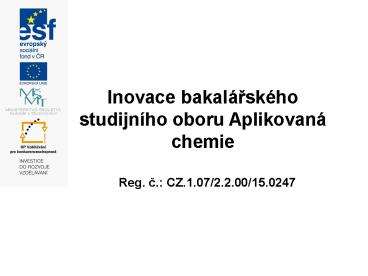N - PowerPoint PPT Presentation
Title:
N
Description:
The heat of combustion is the energy released as heat when a compound undergoes complete combustion with oxygen ... Calorimetry Bomb calorimeter Technique to ... – PowerPoint PPT presentation
Number of Views:100
Avg rating:3.0/5.0
Title: N
1
Inovace bakalárského studijního oboru Aplikovaná
chemie
Reg. c. CZ.1.07/2.2.00/15.0247
2
Lecture vocabulary
3
Introduction to Physical Chemistry
- Lecture 4
- Thermochemistry
- The reaction heat
- Laplace-Lavoisiers law
- Hesss law
- Kirchhoff equation
- calorimetry
4
The heat of reaction
Heat of reaction is the amount of heat that must
be added or removed during a chemical reaction in
order to keep all of the substances present at
the same temperature
The units of heat of reaction are kJmol-1 for a
specified reactant or product
The reaction can be exergonic /
endergonic exothermic / endothermic ?Hnegative/
?Hpositive
5
Reaction enthalpy
The reaction enthalpy
Often, instead of looking at things at constant
volume, we often look at things at constant
pressure (i.e. we work under ambient atmosphere
in an open vessel). Under such circumstances,
introducing enthalpy is useful
H U pV
Like the energy, the enthalpy is a state
function. The variables involved only depend on
initial and final conditions. The change in
enthalpy at constant pressure is the heat
supplied to the system.
Proof The differential of enthalpy is dH dU
pdV Vdp According to the first thermodynamic
law dU dq dw dq pdV (if expansion work is
the only possible). Combining the expression we
get dH dq pdV pdV Vdp, at constant
presure dH dq.
6
Laplace Lavoisiers law
The energy change accompanying any transformation
is equal and opposite to energy change
accompanying the reverse process.
Laplace collaborated with Lavoisier and
constructed the so-called ice calorimeter. They
were inspired by Joseph Blacks discovery of
latent heat in 1761.
7
Hesss law
The energy change for any chemical or physical
process is independent of the pathway or number
of steps required to complete the process
provided that the final and initial reaction
conditions are the same.
German Ivanovich Gess, August 7, 1802November
30, 1850, was a Swiss-born Russian chemist
- For example
- CH4(g) 2O2(g) ? CO2(g) 2H2O(g) ?H -802 kJ
- 2H2O(g) ? 2H2O(l) ?H - 88 kJ
- CH4(g) 2O2(g) ? CO2(g) 2H2O(l) ?H -890 kJ
8
Heats of formation and heats of combustion
- Standard Heat (Enthalpy) of formation of a given
compound is the enthalpy change of the reaction
by which it is formed from its elements. - The reactants and products are all in a given
standard state. - By definition, the standard enthalpy (heat) of
formation of an element in its standard state is
zero.
The heat of combustion is the energy released as
heat when a compound undergoes complete
combustion with oxygen under standard conditions.
The chemical reaction is typically a hydrocarbon
reacting with oxygen to form carbon dioxide,
water and heat.
9
Kirchoff equation
Gustav Kirchhoff showed in 1858 that the
variation of the heat of reaction with
temperature is given by the difference in heat
capacity between products and reactants d?H /
dT ?Cp. Integration of this equation permits
the evaluation of the heat of reaction at one
temperature from measurements at another
temperature.
10
Calorimetry
Technique to determine reaction heats and heat
capacities
- Usually not constant, but changing with
temperature CabTcT2 - Not defined at phase transition
Heat capacities
dQ CdT
- Specific
- Molar
- At constant volume
- At constant pressure
For ideal gas CpCvR
Calorimetric equation
c1m1(t1 - t) c2m2(t - t2)
Bomb calorimeter
11
Thermoanalytical techniques
Differential scanning calorimetry or DSC is a
thermoanalytical technique in which the
difference in the amount of heat required to
increase the temperature of a sample and
reference is measured as a function of
temperature.
Differential thermal analysis (DTA). In this
technique it is the heat flow to the sample and
reference that remains the same rather than the
temperature. When the sample and reference are
heated identically phase changes and other
thermal processes cause a difference in
temperature between the sample and reference.
Isothermal titration calorimetry (ITC) is a
technique used to determine the thermodynamic
parameters of interactions in solution. As
chemical reactions occur in the sample cell, heat
is generated or absorbed. The temperature
difference between the sample and reference cells
due to chemical reactions occuring in the sample
cell is kept at a constant value (i.e. baseline)
by the addition or removal of heat to the sample
cell.
12
(No Transcript)































